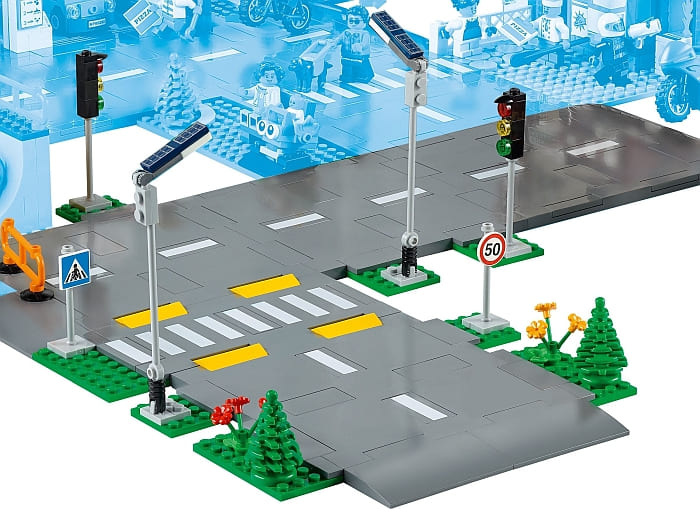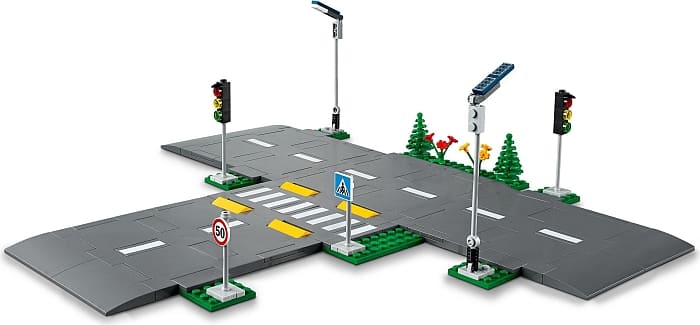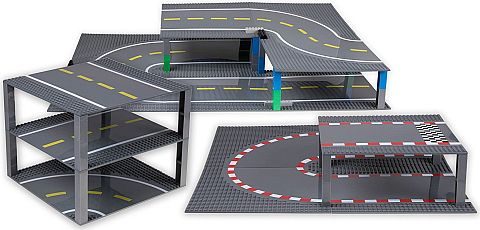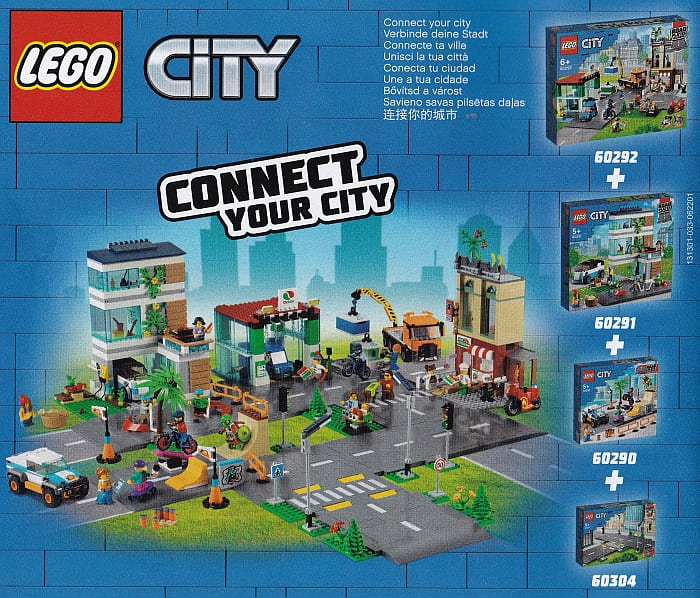There has been a lot of talk about the new LEGO road plate system introduced with the 2021 LEGO City sets. LEGO fans with large LEGO city displays are curious what possibilities the new system offers, how the new system fits with the old, and if it is worth to switch over to the new system. We talked about all five of the new sets as well as the new road plates in detail (see links at the end of this post), but we discussed only briefly how the new road plates fit the old system. This is mostly because my LEGO city display is on long shelf and I only have a narrow brick-built road. Thus, I could not demonstrate the compatibility of the old and new road systems. However, recently, JANGBRiCKS posted a video with valuable information about the compatibility of the two systems.

As you probably know, JANG has a very large LEGO city display, and he is heavily invested in the old LEGO road plates. In the video (which I have included below), he talks about the similarities and differences between the old and new road plate systems, the challenges when trying to combine them, and some possible solutions. His ideas and demonstrations are particularly valuable to those who would like to combine the two systems.
Whether you use traditional road plates, the new road plate system, or brick-built roads, the easiest solution is to commit to just one system and use that throughout your city. However, this is not always possible or practical. And each of the systems have plusses and minuses. The old road plates offer a uniform system and they are also compatible with the LEGO Modular Buildings, however they take up a lot of space with their fixed size, and LEGO no longer makes them. Brick-built roads provide great versatility and customization options, but they are parts-heavy (and thus expensive), and are most suited for displays without the need for an extensive network of roads. The new road plate system is cheaper than brick-built roads while still providing plenty of options for customization. On the other hand, they are not readily compatible with traditional road plates and sets built on traditional baseplates (like the LEGO Modular Buildings), and there are no modules for curved roads.

If you’re new to building a LEGO city, I recommend spending some time figuring out which system you want to commit to. If you already have a LEGO city that uses the old road plates, you have three main options. You can decide to stick with traditional road plates, but keep in mind that it is going to become increasingly difficult to get additional plates. They are no longer available directly from LEGO, but you can still get them on Amazon:

Another option would be to replace all of your old road plates with the new system. This is going to cost quite a bit of time, money, and planning, but you will have a more versatile and customizable road system that you should be able to expand well into the future. (If you do go this route, you should be able to sell your old road plates to recoup some if not all of your expenses, but this will take some time to accomplish.) You can purchase the new road plates in several of the 2021 LEGO City sets, as well as in a road plates pack. This set is available at both Amazon and the Online LEGO Shop:

The third option is to develop a hybrid road system with both old and new road plates, as demonstrated by JANG in the video. The main issue here is that you will have to constantly fight and try to accommodate the height difference between the old and new systems. One way to mitigate this is to use the new system in strategic places; inner roads, parking lots, airports, tunnels, elevated roads, etc., and use the old road plates throughout the rest of the city. This way, you have to deal with the height differences at fewer junctions. I have used the type of foam core boards that JANG mentions in his video in my own city (for a different reason), and they did work very well. However, eventually I replaced them with a brick-built solution as it kind of bothered me that they were not part of the LEGO system. But I do recommend them as a high quality and versatile product. They are available at office supply stores as well as on Amazon:
Another interesting product JANG mentioned is the large LEGO plates by Strictly Briks. We have reviewed these years ago, I use them myself, and I highly recommend them. They are available in a myriad of LEGO-compatible colors and are very high quality. Also, JANG didn’t mention this in the video, but this same company also makes 32×32 size straight and curved road plates printed on standard size plates with studs on top and tubes on the bottom (instead of the thin material LEGO used for their old road plates). So, if you like the look and size of old LEGO road plates, but you don’t like that they are thinner than standard plates, you can just switch over to this system and get an entire road network without height differences. And as the Strictly Briks road plates are one standard plate tall, they are already compatible with LEGO’s new road plates. You can find both the plain plates, the road plates, as well as plates in other shapes and sizes at the company’s website and on Amazon:

We talked about the plusses and minuses of the new road plate system in our previous reviews, but one plus I would like to emphasize here is the customization options. You can make the roads as narrow or as wide as you want, with as many lanes as you want, add bike lanes, speed bumps, sidewalks, vegetation, and more. This makes them superior to old road plates. And they also fit the LEGO building system better with standard measurements, and attachment points both on top and bottom. JANG didn’t demonstrate this in his video, but these road plates are perfect for paving narrow roads to large surfaces like airports. And they can even be used for building elevated roads, bridges, and more. Even if you decide to stick with the old road plate system, I recommend getting at least one of the #60304 LEGO City Road Plates and play with the possibilities. You can find all the sets with the new road plates at the LEGO City section of the Online LEGO Shop.

What do you think? How do you like the new LEGO road plate system? Are you planning to give it a try? What system do you use for your own LEGO city? Feel free to share your thoughts and discuss in the comment section below!
And you might also like to check out the following related posts:












Could someone please explain to me what the yellow blocks in the new road system are all about? Speed bumps in a public road are dangerous. They belong only in parking lots and private property. Also, is Lego discontinuing the old street plates? Those are all I am willing to use. If they discontinue them my city will have no roads. This latest road design is super expensive and leaves low income builders out of the picture. Kind of like the US government doesn’t like low income families so they cut social programs. PS. I don’t slow down for speed bumps. I tend to accelerate hard over them to get a wheel hop and piss off parking lot security.
I don’t know how it is in Europe, but in the US, speed bumps are very common on city roads. They are usually installed where traffic turns off from higher speed limit streets to residential areas. It’s an extra reminder (besides the speed limit signs) to slow down.
As far as the old plates, it has been confirmed by LEGO that the standard baseboards aren’t retired, however we are still waiting on confirmation about the status of road plates.
If you use a lot of the new roads, don’t you have many extra ramp pieces?
Do they sell just the tiles for the new roads? If yes, you can (I assume) put the tiles on the standard 10 x 10 green baseplates or the 15 x 15 grey baseplates. Does that come out cheaper?
How about big triangle tiles to make angled roads?
So far, I can’t see a reason to switch. Knockoff roadplates here I come.
SO MUCH TO CONSIDER!
Yeah, there still seems to be several third party companies selling compatible roadplates based on the older system.
Those strictly bricks plates look awesome. Maybe even better than Lego. But I kind of like the new road plates. I like that they can make narrower roads. Road plates take up so much space.